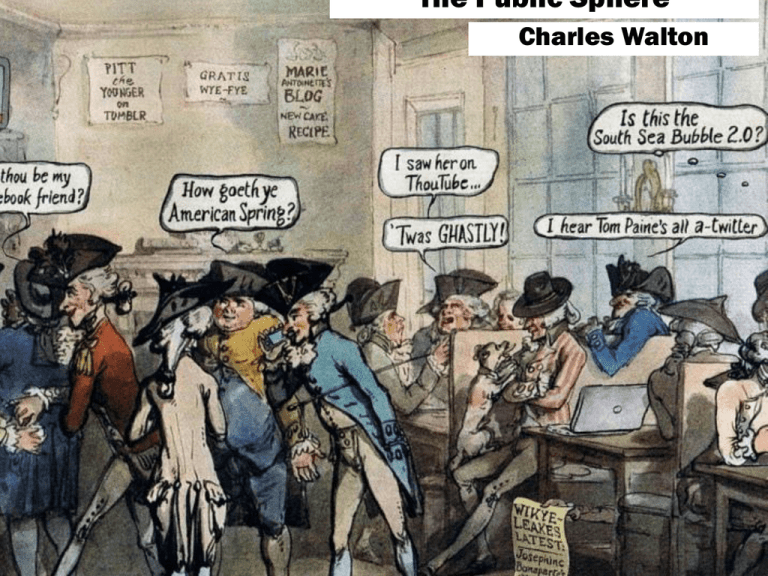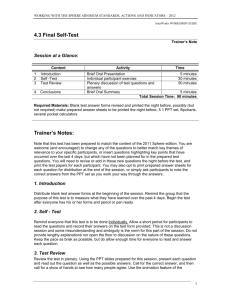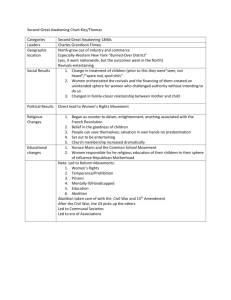The Public Sphere
advertisement

The Public Sphere Charles Walton What did the c18th public sphere look like? The Public Sphere Charles Walton Immanuel Kant What is Enlightenment? (1784) • Private use of reason: – Officer in a civic post – Can be limited • Public use of reason: – A scholar speaking to the general public – Motivated by the desire to rationally address matters, not self-interested • What is the public? • What does it have to do with Enlightenment? • Did it have an impact on radicalism and revolution in the late 18th century? What is the public sphere? Jürgen Habermas The Structural Transformation of the Bourgeois Public Sphere (1962) The public sphere • a space of rational-critical debate • where private individuals come together to form a ‘public’ • where ‘public opinion’ is formed and expressed, often in critique or opposition to the state or the ruling elite. By the ‘public sphere’ we mean first of all a realm of our social life in which something approaching public opinion can be formed. Access is guaranteed to all citizens. A portion of the public sphere comes into being in every conversation in which private individuals assemble to form a public body. They then behave neither like business or professional people transacting private affairs, nor like members of a constitutional order subject to the legal constraints of a state bureaucracy. Citizens behave as a public body when they confer in an unrestricted fashion -- that is, with the guarantee of assembly and association and the freedom to express and publish their opinions -- about matters of general interest. (Habermas ,’The Public Sphere: An Encyclopedia Article’, New German Critique 3 (1974): 49) Where did the public sphere come from? State/civil society split • Rise of the state (as distinct from civil society) • Rise of capitalism (socioeconomic power develops beyond total grasp of state) • State + Capitalism = new bourgeois family – Sentiment, sociability, individuality, education • These new attributes get projected onto public domains (print, clubs, theatres, salons) Medieval Household Bourgeois household Greuze, mid-18th century Bourgeois household Boucher (mid 18th century) How historians have engaged with Habermas’s model • Did the public emerge within the private sphere, or did state institutions play a role in creating it, directly or indirectly? • Was the public sphere exclusively ‘bourgeois’? • Was it truly egalitarian? (Gender, class inequalities may have persisted, despite egalitarian rhetoric) How did ‘the public’ develop a legitimate political voice? • Robert Darnton: content of public opinion – Irreverence, historical narratives of regime’s decline • Roger Chartier: skepticism developed in response to the proliferation of ideas and opinions – Individuals learn to discern fact from fiction, honest criticism from libel and slander. Readers become less reverential about texts and truth claims: monarchy and church pay the price • Keith Baker: ‘public opinion’ as a concept is erected into an authority – A court of last appeals: the tribunal of public opinion What are we trying to explain in identifying a public sphere? • Emergence of English radicalism and the French Revolution in the late 18th century • Grievances before the emergence of public opinion: expressed through guilds, corporations, caste, religion… or violence • Grievances after its emergence: public discussion oriented towards the common good – NOTE: the ‘public’ as a horizontal conception of society • Individuals as commensurate moral equals • The nation as the outer-limit of the ‘public’… • subjects recast as citizens Exclusion and the public sphere • ‘The early bourgeois public spheres were composed of narrow segments of the European population, mainly educated, propertied men, and they conducted a discourse not only exclusive of others but prejudicial to the interests of those excluded.’ • ‘The very emphasis on rational-critical debate implies an incapacity to deal fairly with “identity politics” and concerns for difference.’ Craig Calhoun, Introduction, Habermas and the Public Sphere (Massachussetts: MIT press, 1992)p.3 Where were the ‘publics’? • • • • • Print culture (more next week) Theatres Clubs Drinking publics (coffee houses, pubs) Salons Theatre 18th Century English Theatre • Patronised by the Court • Heavily censored – Licensing Act of 1737 – Scripts submitted to Lord Chamberlain – Even Shakespeare’s scripts were modified • Types of theatre publics: highbrow, lowbrow – Commercialisation rise of spectacles, vaudeville, musicals – Official theatres begin adapting by 1760s French Theatre • Official institutions for performance – Held monopolistic privileges over types of performances • Comédie-française • Opéra • Comédie-Italienne; Fairground Theatres – Itinerant troupes – Judicial battles: infringed upon Comédie-française’s monopolistic privileges – Eventually move to fixed vaudeville houses, mid-18th c – Privileged theatres need to diversify in order to compete with the ‘low-brow’ theatres – ‘Low-brow’ theatres become more moralising: theatre as education Spectators into publics • When itinerant troupes move to standing theatres – regular spectators begin asserting their authority and demanding diversity in performances • Commercialisation – consumers’ voice – Raucous: Tossing fruit on stage – Interrupting actors, changing the lines to make comments about current events – Strikes, boycotts, cabales… • Push and pull of authority over playbills – Spectators become ‘publics’, even ‘the nation’: they press troupes to perform what they (the spectators) want to see – Elites try to discipline audiences • Theatre as a school, education • Police guards, troops, spies in the theatres • Benches in the parterre (the ‘pit’): discipline the parterre Clubs and academies • English Clubs – Early attempts: party aligned, led by nobles • Restoration (1660s) • Early 18th century – 1760s… more diverse, generators of opinion • Clubs, masonic lodges, patriotic societies, trade associations, mutual-aid organisations • Served as social and economic networks and cushions – Illness, unemployment, debts Freemasons • Voluntary but secret organisations – London 1717 – Paris 1725 • Membership – Initially aristocratic with broader social membership across 18th century – Many booksellers and printers belonged (generators of printed ideas!) • Theoretically egalitarian – – – – Women’s lodges in France (lodges of adoption) ‘Brothers’ and ‘sisters’ fraternity ‘commerce’ is valued, on all levels Somewhat mystical, somewhat Enlightened English freemasons • Whig in orientation, pro-court in mid early 18th century • Spoke of ‘constitutions’; voted • Sociability: knowledge through civilised discussion John Wilkes Affair • MP in the Pitt-wing of the Whigs • Opposition to George III’s ministry in 1762-63 • Newspaper: The North Briton – Criticised the Treaty of Paris (1763) and insinuated that the king’s favourite, Lord Bute, was sleeping with the king’s mother: libel • Of those arrested with Wilkes, many were freemasons • Wilkes’ spoke in the name of ‘public opinion’ and addressed ‘the public’ Utopian aims to reform society • John Whitmarsh (1765) – ‘The two grand pillars of the masonic art [are to] promote civilisation and to adorn human life with every scientific and moral accomplishment.’ • Appropriation of John Locke (1750s-1770s) • Republicanism, revolution, rights-based society Spread to Continent • Holland, Prussia, Russia, Italy, France • Often aristocratic but alternative sociability to older codes of social hierarchy • Members are ‘brothers’ and ‘sisters’ – Idea of fraternity French Academies • Absolutism at war with salons – Richelieu vs. Madame de Rambouillet – (1635) Founding of the French Academy • 18th century: spread to provinces – Elite membership – Scientific experiments, lectures on morality – Philosophes rising influence in them Other sites of public opinion • Public libraries and reading rooms – British Museum Library (1753) – Vienna, Berlin: libraries open to public 9-noon • Cafés – Subscribed to newspapers – Conversation/debate over international affairs – Heavily policed by spies in Paris • Salons (?) Public vs. Community The latter’s decline? • Social bonds become more abstract – Less organised around neighbourhood and parish – Reading/writing communities – With the spread of carriages and street-lamps, people travel further in cities… connect with people beyond their immediate neighbourhood – Masonic lodges – members crossed cities to participate in them • Social stratification as a result? Social exclusions • The public sphere: not necessarily the highroad to democracy • Criteria for counting among the public – Civilised manners, education – Rationality (or the desire to think rationally) – Male dominated public (according to Kant, Rousseau) – Racially inflected (European whites as more capable of reasoning than others) 18th century: apogee of critical public sphere? • Critical thought turns into propaganda after French Revolution (Habermas’s dark view in 1962) • Public opinion: heavily policed and manipulated even during the Enlightenment (historians’ more recent view) Policing, anxieties? • Pierre Bourdieu (French sociologist): ‘public opinion does not exist’! – Manufactured? Noam Chomsky’s Manufacturing Consent (1988) • Yet, continued anxiety, because it may become a real political force that states can’t control.





